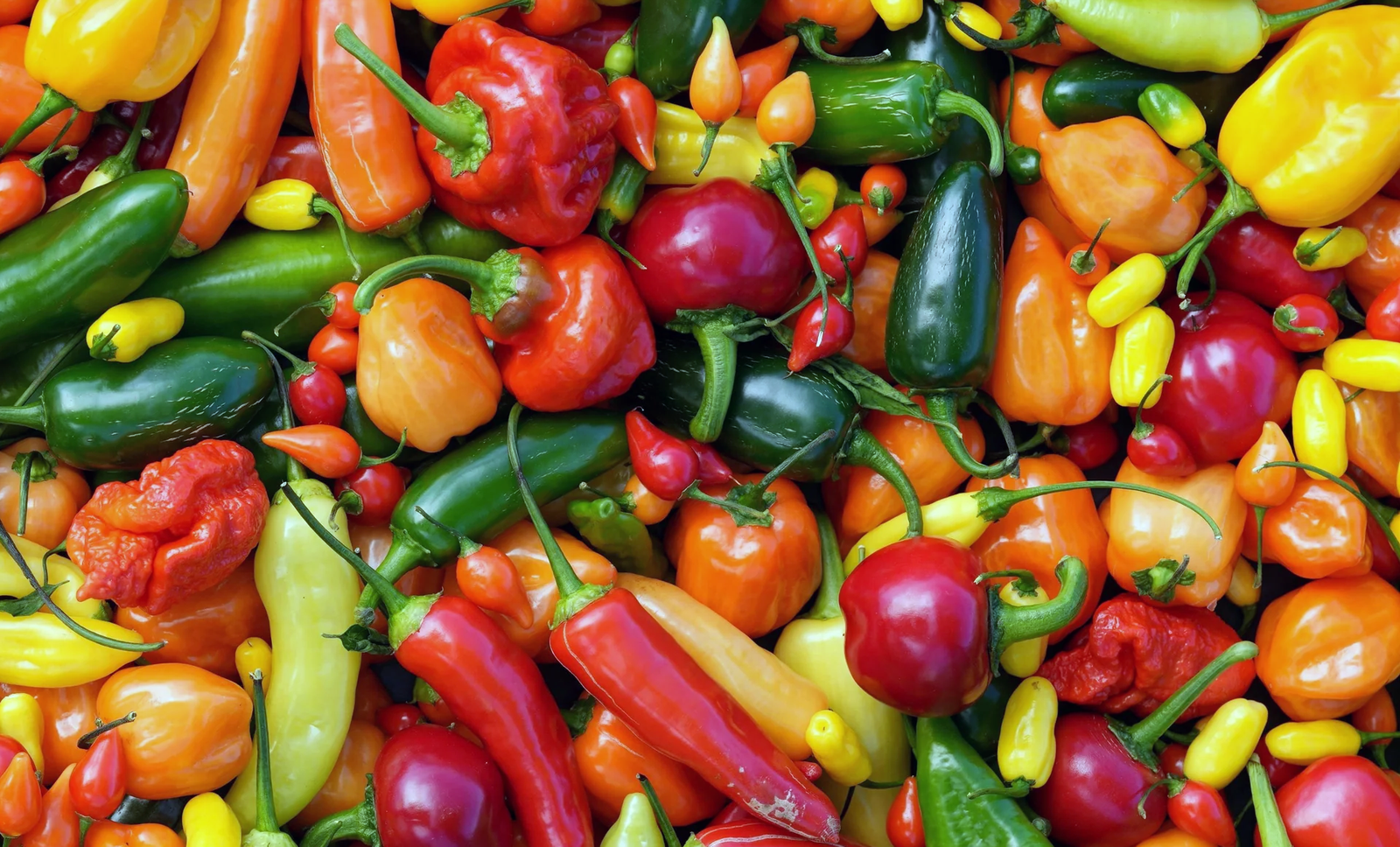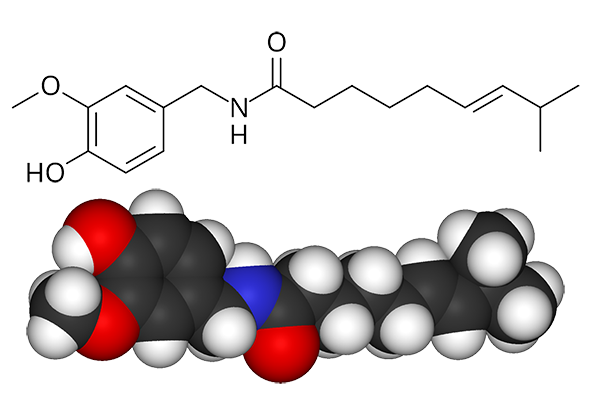FabulousFusionFood's Chilli-based Recipes 8th Page
 A mixture of different chilli peppers.
A mixture of different chilli peppers.
Welcome to FabulousFusionFood's Chilli-based Recipes Page — The recipes presented here all contain chilli peppers as a main ingredient. Chillies are the fruit of the chilli plant. Along with black pepper, they are unique spices in that they impart 'heat' to a dish without any associated bitterness. The dried and powdered fruit along with the fresh fruit and the dried fruit are all used as spices. As well as their capsaicin induced heat, chillies (depending on the variety or cultivar) can also imbue a dish with a fruity flavour. Smoked chillies are also used to impart a smokiness as well as heat to a dish.
Chilli peppers, also spelled chile or chili (from Classical Nahuatl chīlli [ˈt͡ʃiːlːi]) and known as hot peppers, are varieties of berry-fruit plants from the genus Capsicum, which are members of the nightshade family Solanaceae, cultivated for their pungency. Chilli peppers are widely used in many cuisines as a spice to add "heat" to dishes. Capsaicin and the related capsaicinoids give chillies their intensity when ingested or applied topically. Chilli peppers exhibit a range of heat and flavours. This diversity is the reason behind the availability of different types of chilli powder, each offering its own taste and heat level.
Chilli peppers originated in Central or South America and were first cultivated in Mexico. European explorers brought chillies back to the Old World in the late 16th century as part of the Columbian Exchange, which led to the cultivation of multiple varieties across the world for food and traditional medicine. Five Capsicum species have been widely cultivated: annuum, baccatum, chinense, frutescens, and pubescens.
 The capsaicin molecule, chemical structure (top) and space-filling model (bottom).
The capsaicin molecule, chemical structure (top) and space-filling model (bottom).
When peppers are consumed by mammals such as humans, capsaicin binds with pain receptors in the mouth and throat, potentially evoking pain via spinal relays to the brainstem and thalamus where heat and discomfort are perceived. However, birds are unable to perceive the hotness and so they can eat some of the hottest peppers. The intensity of the "heat" of chillies is commonly reported in Scoville heat units (SHU), invented by American pharmacist Wilbur Scoville in 1912. Historically, it was a measure of the dilution of an amount of chilli extract added to sugar syrup before its heat becomes undetectable to a panel of tasters; the more it has to be diluted to be undetectable, the more powerful the variety, and therefore the higher the rating. Since the 1980s, spice heat has been assessed quantitatively by high-performance liquid chromatography (HPLC), which measures the concentration of heat-producing capsaicinoids, typically with capsaicin content as the main measure
The alphabetical list of all the chilli-based on this site follows, (limited to 100 recipes per page). There are 1584 recipes in total:
Page 8 of 16
| Kalia (Meat and Potato Curry) Origin: Bangladesh | Khatmitthi Raani (Tamarind Chutney) Origin: India | Kuchela Origin: Trinidad |
| Kalia II (Meat and Potato Curry II) Origin: Bangladesh | Khatta Curry Origin: India | Kuka Soup Origin: Nigeria |
| Kaluun iyo Bariis (Spicy Fish Sauce with Rice) Origin: Somalia | Khatta Meetha (Cabbage Curry) Origin: India | Kurmanash Origin: India |
| Kalya de Poulet (Chicken Kalya) Origin: Mauritius | Khichiri Prawn Sauce Origin: India | La Capitaine Sangha (Nile Perch with Red Sauce) Origin: Mali |
| Kanda ti Nyma Origin: Central African Republic | Khnom Jin Namya (Catfish Curry over Noodles) Origin: Thailand | Laal Chicken Curry Origin: Britain |
| Kang Ped Pla-dook (Red Curry with Catfish) Origin: Thailand | Khowsuey Origin: Chile | Laal Maas (Rajasthani Lamb Curry) Origin: India |
| Kangchu Tsoem (Pig's Trotter Tshoem) Origin: Bhutan | Kibeba (Cassava and Cuttlefish Stew) Origin: Mozambique | Laap (Beef Salad) Origin: Laos |
| Kansiyé de Poisson (Fish Kansiyé) Origin: Guinea | Kibeba de Angola Origin: Angola | Lablabi Origin: Tunisia |
| Kansiyé de Poulet (Chicken Kansiyé) Origin: Guinea | Kima (Chopped Beef and Chilli Fry) Origin: Senegal | Laj Ntses (Fish Larb) Origin: Laos |
| Kari Ayam (Malaysian Chicken Curry) Origin: Malaysia | Kimchi Origin: Korea | Laksa Paste Origin: Singapore |
| Kari Ikan (Fish Curry) Origin: Malaysia | Kiseli Kupus Origin: Croatia | Laksa Paste Origin: Malaysia |
| Kashmiri Chicken Curry Origin: India | Kissuto Rombo (Baked Kid Goat) Origin: Sao Tome | Laksa Paste II Origin: Malaysia |
| Katakou au Poisson Frais (Palm Soup Base with Fresh Fish) Origin: Cote dIvoire | Kjufteta Po Cirpanski (Meatballs and Potatoes) Origin: Bulgaria | Lamb Dhan Saag Origin: India |
| Katchourie Origin: Trinidad | Kobi Bhaji Origin: India | Lamb Jalfrezi Origin: India |
| Ke'lagu'en Uhang (Prawns and Peppers) Origin: Guam | Kobi Keema (Cabbage and Minced Meat Curry) Origin: India | Lamb Koftas Origin: North Africa |
| Ke'lagu'en Uhang (Prawns and Peppers) Origin: Northern Mariana Islands | Kobi Sabji (Cabbage Sabji) Origin: India | Lamb Rogan Josh Origin: India |
| Kebab with Garlic Origin: Western Sahara | Kofta Curry (Meatball Curry) Origin: Pakistan | Lao Tam Som (Lao Green Papaya Salad) Origin: Laos |
| Kedjenou Origin: Cote dIvoire | Koki Origin: Cameroon | Lasary Citron (Lemon Condiment) Origin: Reunion |
| Kedjenou II Origin: Cote dIvoire | Kokoda (Oceanian Ceviche) Origin: Fiji | Lasary Manga (Mango Condiment) Origin: Madagascar |
| Keema and Lettuce Curry Origin: India | Kokoda (Fijian Ceviche) Origin: Fiji | Lauki Raita (Bottle Gourd Raita) Origin: India |
| Keema Mattar Origin: India | Kokoda (Oceanian Ceviche) Origin: Papua New Guinea | Laza Hot Sauce Origin: Kyrgyzstan |
| Kejenou avec Agouti (Kejenou with Cane Rat) Origin: Cote dIvoire | Kokoda (Oceanian Ceviche) Origin: Solomon Islands | Laza Hot Sauce Origin: China |
| Kelaguen Mannok (Chamorro-style Chicken Salad) Origin: Guam | Kokum Kari (Kokam Curry) Origin: India | Laza Hot Sauce Origin: Uzbekistan |
| Kelaguen Mannok (Chamorro-style Chicken Salad) Origin: Northern Mariana Islands | Komprek Eromba (Water Dropwort Eromba) Origin: India | Laza Hot Sauce Origin: Kazakhstan |
| Kenyan Chilli Tomato Sauce Origin: Kenya | Kondré de Porc (Kondré of Pork) Origin: Cameroon | Laza Hot Sauce Origin: Russia |
| Kenyan Matoke Origin: British | Konkoé Turé Gbéli (Smoked Catfish Stew with Vegetables) Origin: Guinea | Laza Hot Sauce Origin: Turkey |
| Kerala Plantain Errisery Origin: India | Kontomire Stew (Cocoyam Leaf Stew) Origin: Ghana | Le Koki (Bean Cake) Origin: Chad |
| Kerrieboontjies (South African Curried Beans) Origin: South Africa | Korma Masala Origin: India | Le Koki de Cameroun (Cameroonian Bean Cake) Origin: Cameroon |
| Ketoun (Guinean Root Vegetable Porridge) Origin: Guinea | Koshari (Egyptian lentils) Origin: Egypt | Le Ndolé Camerounais (Cameroonian Ndolé) Origin: Cameroon |
| Kewa Datshi (Potatoes with Cheese) Origin: Bhutan | Kotor Bay Stewed Fish Origin: Montenegro | Le Rougail Boucané (Smoked Pork Rougail) Origin: Reunion |
| Kewa Phagsha (Spicy Pork with Potatoes) Origin: Bhutan | Kouti (Cassava Croquettes) Origin: Guinea | Leftover Roast Beef Jalfrezi Origin: Anglo-Indian |
| Khanom Jeen Nam Ya (Khanom Jeen Noodles) Origin: Thailand | Kpakpo Shito (Fresh Shitor) Origin: Ghana | Leftovers Jalfrezi with Gravy Origin: India |
| Khanom Jeen Nam Ya (Khanom Jeen Noodles) Origin: Thailand | Krain Krain (Jute Leaf Stew) Origin: Sierra Leone | |
| Kharcho (Georgian Beef and Rice Soup) Origin: Georgia | Kuah Kuning (Yellow Gravy Soup) Origin: Papua |
Page 8 of 16